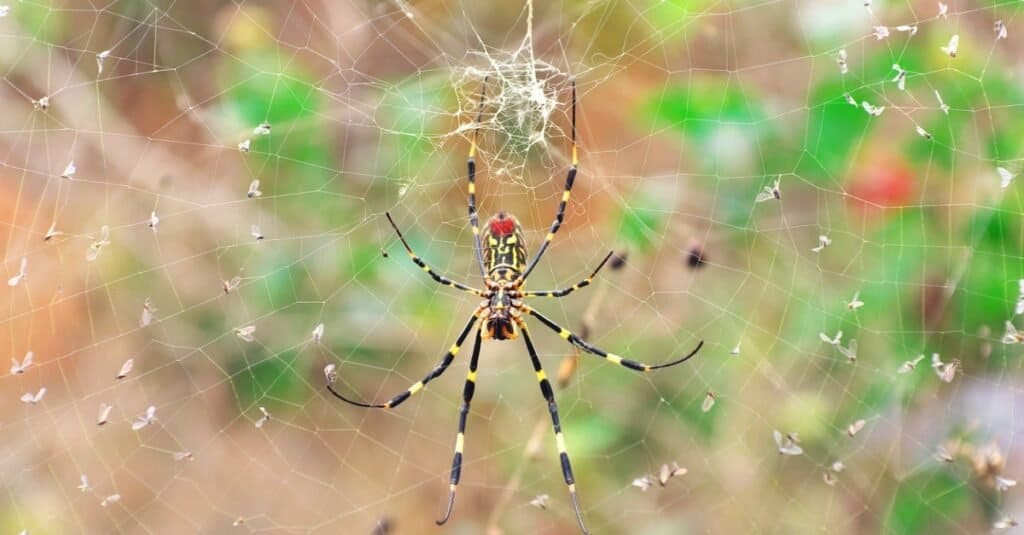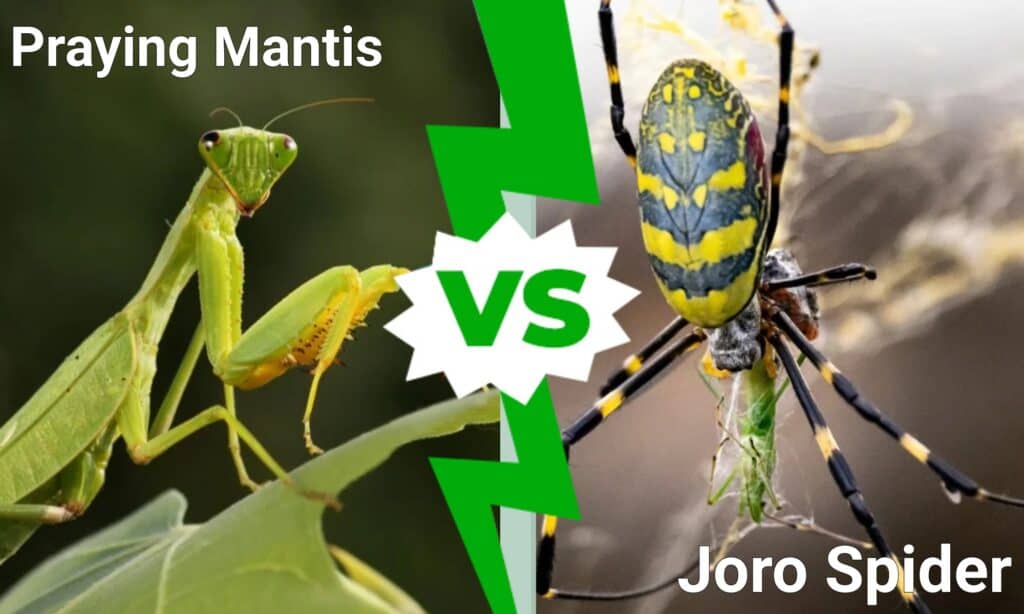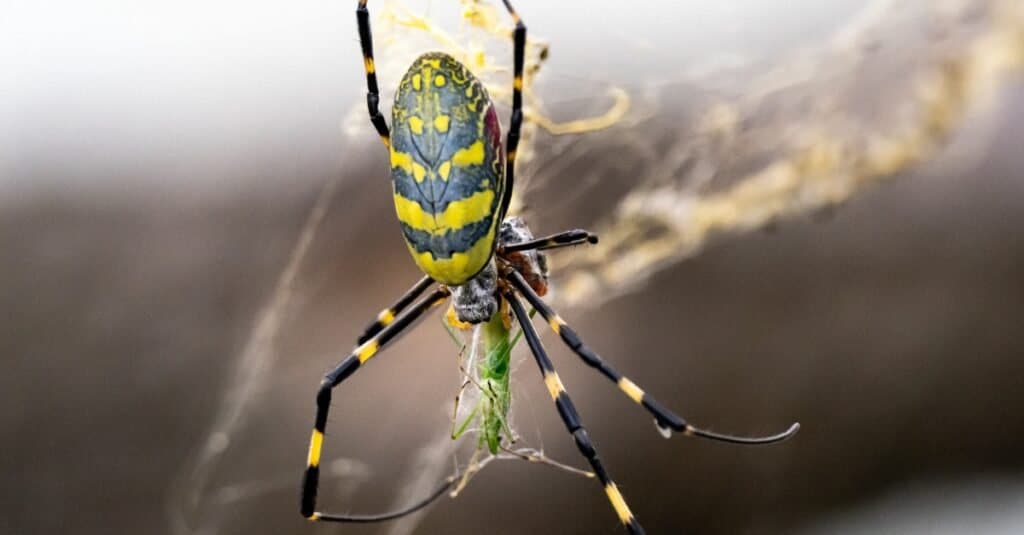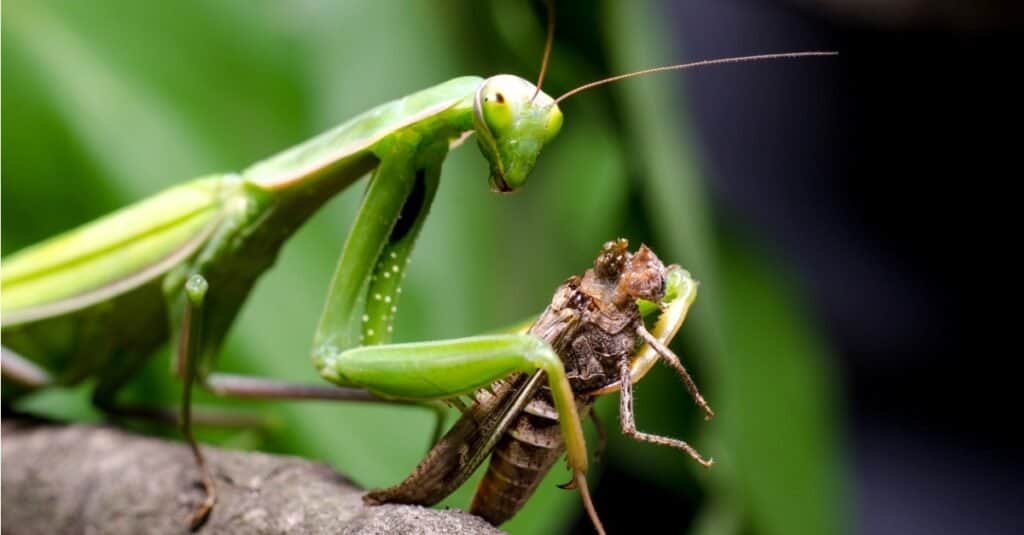Joro Spider vs. Praying Mantis: Who would win in a Fight?
@media (min-width: 481px) {
.mobile-top-content {
display: none;
}
}
#mobileTopContentCTACarouselControls { overflow: hidden; text-overflow: ellipsis; white-space: nowrap; }
.mobile-top-content .more { color: #fff; }
.mobile-top-content a { color: #fff; text-decoration: underline; }
.mobile-top-content a:hover { color: #fff; text-decoration: underline; }
@media (max-width: 480px) {
.mobile-top-content {
background-color: #06a10b;
color: #fff;
text-align: center;
/*height: 60px;
padding-top:5px;*/
font-size:80%;
/* display: block; */
margin: 0px -30px;
}
}
The Joro spider is the new spider in town in the United States. It is a large colorful spider that is from Japan that has made its way to Georgia and South Carolina. It has rapidly reproduced and spread throughout many counties and a recent study by the University of Georgia suggests it could be moving up the East Coast. Praying mantis are already found throughout the US. There are around 2,000 species of mantis that include the Carolina mantis, California mantis and there is even one called the Arizona unicorn mantis! So Joro spider vs praying mantis, what would happen if these two were to meet up. Who would win in a fight? Let’s find out!
What does a Joro spider look like?

Joro spiders are large colorful spiders that have bodies that are about an inch long and 8 skinny legs that can span 3 inches. Their bodies are bright yellow and black with red markings on their back and underside. Their legs are striped with yellow and blue bands. The females are the ones that are colorful and large with the males being only ¼ inch and brown with faint yellow markings. The females spin very large webs of golden silk and the webs are spherical not flat like a typical web. Some of the webs have spread more than 10 feet!
What does a praying mantis look like?

Karel Bartik/Shutterstock.com
Praying mantis are green or brown insects with forearms that look like they are in a praying position. They are about 2-5 inches long and have six legs including their forearms that have sharp spines and sticky pad to help the snatch their prey. Their heads look like an upside-down triangle and have two bulging eyes in each corner. Two long antennae top their heads. They can actually turn their heads 180°!
How do the two compare: Joro spider vs praying mantis

A-Z-Animals.com
| Joro Spider | Praying Mantis | |
| Size | Females ¼ inch to 1 inch body, leg span 3 inches | 2-5 inches long |
| Speed | slow | slow |
| Mobility | Crawls, can balloon (float) on a web-made parachute | Males can fly, crawl |
| Defenses | Large (really large, up to 10 feet wide) sticky web | Camouflage |
| Offenses | Venomous, can use its web to quickly wrap up its prey | Long forearms with sharp spines and sticky pads Powerful mandibles for biting |
| What kind of Predator | Spin web to catch prey, waits for prey to come to the web | Ambush predator, waits for prey, then attacks |
| Temperament | Not aggressive | Aggressive |
Would a Joro spider and Praying mantis ever meet in the wild?
It’s possible. The Joro spiders are limited to only a few states in the US now, but those states, Georgia and South Carolina have praying mantis populations as well. In fact, the Carolina mantis is the official state insect of South Carolina. Joro spiders and praying mantis live in similar habitats as well.
Where would these two meet in the wild?
The most common place these two would meet would be in a backyard garden. Gardens have plenty of prey that both of these depend on. Praying mantis eat caterpillars, beetles, grasshoppers, and even small birds and lizards! Joro spiders eat aphids, wasps, stink bugs, and mosquitoes. Notice that neither one has each other on their menu.
Why is it unlikely they would get in a fight?
It is unlikely these two would get in a fight because neither one actively hunts. They both wait for prey to come to them. Joro spiders wait in their sticky web, praying mantis camouflage themselves and hide on plants.
How do Joro spiders kill and eat their prey?

iStock.com/David Hansche
Joro spiders spin their large golden webs and wait for insects to get caught in the web. They quickly crawl over to the prey and spin a web around the insect so it can’t move. They then bite the insect with their fangs, injecting it with venom. The venom paralyzes the prey and then they use digestive enzymes to break down the insects. That is when the Joro sucks the nutrients out of the insect.
How do praying mantis kill and eat their pray?

iStock.com/artas
Praying mantis are very camouflaged. Some have wings that look just like a green leaf, while others look just like twigs on branches. By blending in so well with their surroundings it is easy to see how they can wait for an unsuspecting beetle to crawl by and in a split second lurch at it. The praying mantis uses its forearms to snatch its prey. Their forearms are covered in tiny spikes that grasp the prey and also have tiny sticky pads that help keep the prey in place. Here is where the praying mantis wins some intimidation points. They rip the head off their prey with their sharp mandibles and start vigorously chewing. Then they devour the reaming body quite quickly.
One research study showed that “praying mantis can change their behavior based on how well fed they are.” They watched praying mantis waiting for cockroaches (which the researchers provided). The mantis remained still with eyes fixed on the cockroach until it was 1-2 cm away and then it would lurch and attack. As they got full they paid less attention to the cockroaches that were further away, losing interest in ones that were 20 cm away. Researchers hypothesized that insulin was the hormone responsible for changing their approach as they got full.
What is the biggest intimidation factor for both?
The female mantis and spider both get intimidation points from their “habit” of eating their mates after mating! Some female praying mantis will bite the head off their mate and eat them soon after finishing they’ve gotten what they need from them. That is pretty intimidating!
Joro spider vs praying mantis: who would win?
If a very hungry praying mantis had to leave its plant to go find food it could end up as lunch for the Joro spider. Let’s say a male praying mantis (the ones that can fly) flew out of the garden and around the corner of the shed, bam, into a large golden web. The Joro spider could quickly approach it and spin a web around it leaving it wriggling to escape. A sharp bite with its fangs to inject its venom might be where the tides change.
The Joro spider has small fangs that are not even big enough to penetrate human skin so it is unlikely they could pierce the hard shell of the praying mantis. But without the venom, the praying mantis may die from being mummified in the silk. If it were able to wriggle its forearms free it would only take seconds to snatch the Joro spider and bite its head off. Finishing it off for lunch.
It is more likely that the praying mantis would win in a fight with a Joro spider.
More from A-Z Animals
.more-snake-card-image { max-height:140px !important; }
@media (min-width: 481px) {
.mobile-top-content {
display: none;
}
}
#mobileTopContentCTACarouselControls { overflow: hidden; text-overflow: ellipsis; white-space: nowrap; }
.mobile-top-content .more { color: #fff; }
.mobile-top-content a { color: #fff; text-decoration: underline; }
.mobile-top-content a:hover { color: #fff; text-decoration: underline; }
@media (max-width: 480px) {
.mobile-top-content {
background-color: #06a10b;
color: #fff;
text-align: center;
/*height: 60px;
padding-top:5px;*/
font-size:80%;
/* display: block; */
margin: 0px -30px;
}
}
The Joro spider is the new spider in town in the United States. It is a large colorful spider that is from Japan that has made its way to Georgia and South Carolina. It has rapidly reproduced and spread throughout many counties and a recent study by the University of Georgia suggests it could be moving up the East Coast. Praying mantis are already found throughout the US. There are around 2,000 species of mantis that include the Carolina mantis, California mantis and there is even one called the Arizona unicorn mantis! So Joro spider vs praying mantis, what would happen if these two were to meet up. Who would win in a fight? Let’s find out!
What does a Joro spider look like?

Joro spiders are large colorful spiders that have bodies that are about an inch long and 8 skinny legs that can span 3 inches. Their bodies are bright yellow and black with red markings on their back and underside. Their legs are striped with yellow and blue bands. The females are the ones that are colorful and large with the males being only ¼ inch and brown with faint yellow markings. The females spin very large webs of golden silk and the webs are spherical not flat like a typical web. Some of the webs have spread more than 10 feet!
What does a praying mantis look like?

Karel Bartik/Shutterstock.com
Praying mantis are green or brown insects with forearms that look like they are in a praying position. They are about 2-5 inches long and have six legs including their forearms that have sharp spines and sticky pad to help the snatch their prey. Their heads look like an upside-down triangle and have two bulging eyes in each corner. Two long antennae top their heads. They can actually turn their heads 180°!
How do the two compare: Joro spider vs praying mantis

A-Z-Animals.com
| Joro Spider | Praying Mantis | |
| Size | Females ¼ inch to 1 inch body, leg span 3 inches | 2-5 inches long |
| Speed | slow | slow |
| Mobility | Crawls, can balloon (float) on a web-made parachute | Males can fly, crawl |
| Defenses | Large (really large, up to 10 feet wide) sticky web | Camouflage |
| Offenses | Venomous, can use its web to quickly wrap up its prey | Long forearms with sharp spines and sticky pads Powerful mandibles for biting |
| What kind of Predator | Spin web to catch prey, waits for prey to come to the web | Ambush predator, waits for prey, then attacks |
| Temperament | Not aggressive | Aggressive |
Would a Joro spider and Praying mantis ever meet in the wild?
It’s possible. The Joro spiders are limited to only a few states in the US now, but those states, Georgia and South Carolina have praying mantis populations as well. In fact, the Carolina mantis is the official state insect of South Carolina. Joro spiders and praying mantis live in similar habitats as well.
Where would these two meet in the wild?
The most common place these two would meet would be in a backyard garden. Gardens have plenty of prey that both of these depend on. Praying mantis eat caterpillars, beetles, grasshoppers, and even small birds and lizards! Joro spiders eat aphids, wasps, stink bugs, and mosquitoes. Notice that neither one has each other on their menu.
Why is it unlikely they would get in a fight?
It is unlikely these two would get in a fight because neither one actively hunts. They both wait for prey to come to them. Joro spiders wait in their sticky web, praying mantis camouflage themselves and hide on plants.
How do Joro spiders kill and eat their prey?

iStock.com/David Hansche
Joro spiders spin their large golden webs and wait for insects to get caught in the web. They quickly crawl over to the prey and spin a web around the insect so it can’t move. They then bite the insect with their fangs, injecting it with venom. The venom paralyzes the prey and then they use digestive enzymes to break down the insects. That is when the Joro sucks the nutrients out of the insect.
How do praying mantis kill and eat their pray?

iStock.com/artas
Praying mantis are very camouflaged. Some have wings that look just like a green leaf, while others look just like twigs on branches. By blending in so well with their surroundings it is easy to see how they can wait for an unsuspecting beetle to crawl by and in a split second lurch at it. The praying mantis uses its forearms to snatch its prey. Their forearms are covered in tiny spikes that grasp the prey and also have tiny sticky pads that help keep the prey in place. Here is where the praying mantis wins some intimidation points. They rip the head off their prey with their sharp mandibles and start vigorously chewing. Then they devour the reaming body quite quickly.
One research study showed that “praying mantis can change their behavior based on how well fed they are.” They watched praying mantis waiting for cockroaches (which the researchers provided). The mantis remained still with eyes fixed on the cockroach until it was 1-2 cm away and then it would lurch and attack. As they got full they paid less attention to the cockroaches that were further away, losing interest in ones that were 20 cm away. Researchers hypothesized that insulin was the hormone responsible for changing their approach as they got full.
What is the biggest intimidation factor for both?
The female mantis and spider both get intimidation points from their “habit” of eating their mates after mating! Some female praying mantis will bite the head off their mate and eat them soon after finishing they’ve gotten what they need from them. That is pretty intimidating!
Joro spider vs praying mantis: who would win?
If a very hungry praying mantis had to leave its plant to go find food it could end up as lunch for the Joro spider. Let’s say a male praying mantis (the ones that can fly) flew out of the garden and around the corner of the shed, bam, into a large golden web. The Joro spider could quickly approach it and spin a web around it leaving it wriggling to escape. A sharp bite with its fangs to inject its venom might be where the tides change.
The Joro spider has small fangs that are not even big enough to penetrate human skin so it is unlikely they could pierce the hard shell of the praying mantis. But without the venom, the praying mantis may die from being mummified in the silk. If it were able to wriggle its forearms free it would only take seconds to snatch the Joro spider and bite its head off. Finishing it off for lunch.
It is more likely that the praying mantis would win in a fight with a Joro spider.






